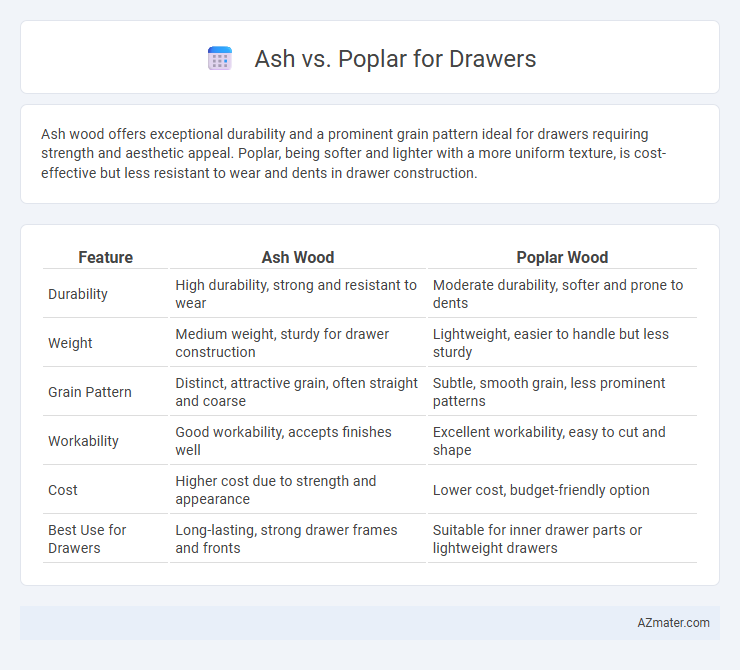Ash wood offers exceptional durability and a prominent grain pattern ideal for drawers requiring strength and aesthetic appeal. Poplar, being softer and lighter with a more uniform texture, is cost-effective but less resistant to wear and dents in drawer construction.
Table of Comparison
| Feature | Ash Wood | Poplar Wood |
|---|---|---|
| Durability | High durability, strong and resistant to wear | Moderate durability, softer and prone to dents |
| Weight | Medium weight, sturdy for drawer construction | Lightweight, easier to handle but less sturdy |
| Grain Pattern | Distinct, attractive grain, often straight and coarse | Subtle, smooth grain, less prominent patterns |
| Workability | Good workability, accepts finishes well | Excellent workability, easy to cut and shape |
| Cost | Higher cost due to strength and appearance | Lower cost, budget-friendly option |
| Best Use for Drawers | Long-lasting, strong drawer frames and fronts | Suitable for inner drawer parts or lightweight drawers |
Introduction: Comparing Ash and Poplar for Drawer Construction
Ash offers exceptional durability and a pronounced grain pattern, making it a preferred choice for sturdy, aesthetically appealing drawer construction. Poplar, while softer and easier to work with, provides a smooth surface ideal for painting and cost-effective builds but may lack the longevity and visual richness of ash. Selecting between ash and poplar depends on balancing the desired strength, appearance, and budget for drawer projects.
Wood Characteristics: Ash vs Poplar
Ash wood is known for its strength, hardness, and attractive grain patterns, making it highly durable and visually appealing for drawer construction, especially in high-use areas. Poplar, on the other hand, is softer and lighter with a more uniform texture, which makes it easier to work with but less resistant to dents and wear over time. Ash tends to offer better shock resistance and longevity, whereas poplar is cost-effective and takes paint well, ideal for painted drawer fronts.
Durability and Strength Analysis
Ash wood exhibits superior durability and strength compared to poplar, making it an ideal choice for drawer construction requiring long-lasting performance. Its high density and resistance to wear ensure that ash drawers withstand heavy use without warping or denting. Poplar, while softer and easier to machine, is more prone to damage and less suitable for high-stress applications demanding robust structural integrity.
Workability and Ease of Machining
Ash offers excellent workability and ease of machining due to its straight grain and uniform texture, making it ideal for drawer construction. Poplar is also easy to machine, but it tends to have a softer composition and may dent or scratch more easily under stress. Both woods respond well to sanding and finishing, but ash provides greater durability and smoother detailing in drawer fabrication.
Grain Pattern and Visual Appeal
Ash wood features a prominent, straight grain pattern with a light color that enhances the natural look of drawers, creating a clean and uniform visual appeal. Poplar, in contrast, often has a more subdued grain with occasional knots and color variations ranging from greenish to pale brown, producing a softer, more muted aesthetic. Both woods are favored for drawer construction, but ash's distinct grain offers a striking, contemporary appearance, while poplar provides a subtle, versatile backdrop suited for painted finishes.
Weight and Suitability for Drawers
Ash wood is lighter than poplar, making it an excellent choice for drawers where weight is a concern, such as in larger or frequently moved furniture. Poplar is heavier and denser, providing durability and sturdiness but potentially making drawers more cumbersome. Ash's combination of strength and lightness ensures smooth operation and longevity, while poplar suits applications requiring a solid, robust drawer structure.
Cost Comparison: Ash vs Poplar
Ash wood typically costs more than poplar due to its greater density, durability, and attractive grain patterns, making it a preferred choice for high-quality drawers. Poplar is generally more affordable, offering a budget-friendly option with decent strength but a less appealing finish, often requiring paint or veneer to enhance appearance. Choosing between ash and poplar for drawer construction depends on balancing cost constraints with desired aesthetics and longevity.
Staining, Finishing, and Paintability
Ash offers excellent stain absorption and a smooth finish, making it ideal for achieving rich, natural wood tones on drawer surfaces. Poplar's tight grain and uniform texture result in superior paintability, providing a smooth base that minimizes blotching and ensures even color coverage. Both woods respond well to finishing, but ash's open grain requires careful sealing, while poplar's closed grain naturally supports a more consistent finish under paint.
Environmental Considerations and Sustainability
Ash wood offers renewable sourcing with fast growth rates, making it an eco-friendly choice for drawer construction, while poplar wood is also sustainably harvested due to its rapid maturity and minimal chemical treatment requirements. Both species store carbon effectively during growth, contributing to carbon footprint reduction in furniture production. Selecting ash or poplar drawers supports responsible forestry practices and reduces environmental impact compared to hardwoods with slower growth cycles.
Best Applications: Choosing Between Ash and Poplar for Drawers
Ash wood is best suited for drawer fronts and sides where durability and an attractive grain pattern are important, as it offers excellent strength and impact resistance. Poplar is ideal for internal drawer components or painted finishes due to its smooth texture and ease of machining, though it is softer and less durable than ash. Choosing ash enhances longevity and aesthetics in high-use drawers, while poplar provides a cost-effective option for concealed or decorative drawer parts.

Infographic: Ash vs Poplar for Drawer
 azmater.com
azmater.com